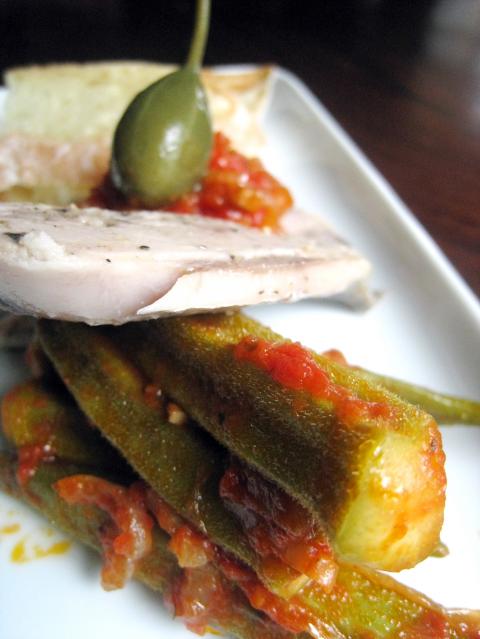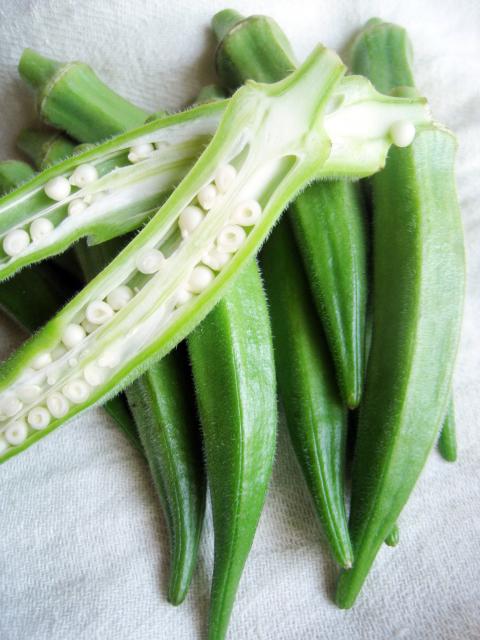Okra is probably best known as a staple of the American south and to a lesser extent as a common ingredient in various African cuisines. Despite numerous outstanding qualities it has failed to achieve acceptance outside various “ethnic” cuisines, despite its robustness as a crop and its many nutritional benefits.
Okra is widely available in Taiwan, but even the Council of Agriculture Web site admits that the popular association with having a gooey texture has held back its popularity, despite a growing acceptance among those looking for healthy eating options.
Okra has an impressive nutritional profile and it is a great source of vitamin A, vitamin C, B vitamins and the phytonutrients glutathione, xanthin, lutein and beta carotene. Its mucilage is an excellent source of soluble dietary fiber that helps with easing constipation. Okra is the whole package, and it is low in calories as well.

Photo: Ian Bartholomew
In fact, according to a report on the Time Web site, quoting Kantha Shelke, a food scientist at Corvus Blue LLC and spokesperson for the Institute of Food Technologists (IFT), “It was the preferred vegetable for the Olympic athletes of the Beijing Olympic Games.” The same report goes on to say that it gained the name “plant Viagra” among athletes. (Their shape is in some degree to blame, but okra does also contain substances called polysaccharides that are thought to open up the arteries in a similar way to Viagra).
With such a write up, one would have thought that okra would be flying off supermarket shelves. Sadly, this is not the case.
Okra has a long growing season and is available in Taiwan from April through to November, with its peak season from May to September. They are widely, if un-ostentatiously, available throughout the year, but recent bad weather, which has sent the price of many leaf vegetables skyrocketing, has seen okra come to the fore and it is now everywhere to be seen in our traditional market.

Photo: Ian Bartholomew
The best eating is to be had from small firm okra. These can be light or dark green, or even a dark red. Avoid large pods as these can be overly fibrous.
One of the easiest preparations, and one that is increasingly making an appearance among side dishes at local Taiwanese eateries, is cold boiled okra (涼拌秋葵). It involves nothing more than simply boiling or steaming the okra for four or five minutes and then immediately immersing it in ice water. The dish is served with a variety of toppings, commonly a mix of soy, sesame oil and garlic, but my own preference is for nothing more than olive oil and some good sea salt.
Even in this simple preparation, one must be careful not to overcook the okra, as it can become soft and slimy if overcooked.
Indeed, okra is one of those vegetables that can taste truly ghastly if not prepared in the right way. This is not to say they are difficult to prepare, but simply that a little care is required to ensure the desired effect.
This is mostly due to the high level of mucilage to be found in okra, which is responsible for its slimy association. This is a good source of soluble fiber, and is excellent for regulating the bowels, but it can also create an ick factor. Long cooking dissolves the mucilage, one of the reasons that okra is often found in slow cooked dishes such as gumbo, where it acts as a thickening agent, enhancing the texture of the stew. Cooking with acidic vegetables such as tomatoes, or with citrus or vinegar, can also keep the mucilage from getting out of hand.
Other popular preparations include being deep fried, breaded in corn meal or other coating. Such okra crisps are truly delicious, and are considered a delicacy of American Southern cuisine, but the quantity of oil required has made this sumptuous dish something of a rarity in more health conscious parts of the world. A tempura batter is also popular, and this can be very light and airy, but eaten in any quantity, still cannot escape the stigma of all deep fried food. Another preparation is as a pickle, in which the high level of acidity means that the okra is actually crunchy rather than slimy (if all goes correctly).
So, with all this amazing potential, it is clear that okra is one of many excellent vegetables that have been neglected simply because they require some attention to detail. Unlike cabbage or spinach, which seem able to withstand all kinds of abuse and still emerge tasting acceptable, okra has too much personality and needs to be shown a little respect. It certainly gives a lot back in return.
It might be that thinking about okra as a laxative that also helps you get it up might not be the marketing campaign that will help gain okra greater popularity. The fact that it is cheap, packed with flavor and nutrients, and once you know its secrets, is in fact very easy to prepare, might gain it a bigger following.
Hearty stewed okra
Recipe
(Serves 4-6 as a side dish)
This dish works perfectly as a vegetable side or as a main dish served over rice. The combination of a soak in vinegar and the long cooking obscures the less appealing aspect of the mucilage; the okra itself has a velvety texture and the sauce is wonderfully rich and hearty. It is a great introduction to okra for those with misgivings about trying this gooey veggie.
Ingredients
400g okra
1/2 cup rice vinegar
1/8 cup red wine
1/4 cup olive oil
400g diced tomato
1/2 a large onion, thinly sliced
2 cloves garlic, minced
1 tbsp dried oregano
100g salted pork or bacon, finely diced (optional)
200ml vegetable stock
50g tomato paste
Salt and pepper
Directions
1. Wash the okra and trim off the tops. Place in a bowl and douse in a mixture of vinegar, salt and wine. Let them sit for about 30 minutes.
2. Drain and rinse the marinated okra, discarding the liquid.
3. In a large skillet, heat the olive oil and salted pork (if using) over medium heat. Add the onion and saute until soft, about five minutes.
4. Add the okra and saute until the ridges of the okra begin to color, about three minutes. Add the garlic and stir for another minute.
5. Add the tomato and top up with stock. Stir in the oregano. Cook for about 10 minutes then mix in the tomato paste. Add salt and pepper to taste. Reduce heat to a low simmer and cook for about 45 minutes or until the okra is very soft and tender and the sauce thick.
6. Can be served warm or at room temperature.

April 28 to May 4 During the Japanese colonial era, a city’s “first” high school typically served Japanese students, while Taiwanese attended the “second” high school. Only in Taichung was this reversed. That’s because when Taichung First High School opened its doors on May 1, 1915 to serve Taiwanese students who were previously barred from secondary education, it was the only high school in town. Former principal Hideo Azukisawa threatened to quit when the government in 1922 attempted to transfer the “first” designation to a new local high school for Japanese students, leading to this unusual situation. Prior to the Taichung First

Chinese Nationalist Party (KMT) Chairman Eric Chu (朱立倫) hatched a bold plan to charge forward and seize the initiative when he held a protest in front of the Taipei City Prosecutors’ Office. Though risky, because illegal, its success would help tackle at least six problems facing both himself and the KMT. What he did not see coming was Taipei Mayor Chiang Wan-an (將萬安) tripping him up out of the gate. In spite of Chu being the most consequential and successful KMT chairman since the early 2010s — arguably saving the party from financial ruin and restoring its electoral viability —

The Ministry of Education last month proposed a nationwide ban on mobile devices in schools, aiming to curb concerns over student phone addiction. Under the revised regulation, which will take effect in August, teachers and schools will be required to collect mobile devices — including phones, laptops and wearables devices — for safekeeping during school hours, unless they are being used for educational purposes. For Chang Fong-ching (張鳳琴), the ban will have a positive impact. “It’s a good move,” says the professor in the department of

Article 2 of the Additional Articles of the Constitution of the Republic of China (中華民國憲法增修條文) stipulates that upon a vote of no confidence in the premier, the president can dissolve the legislature within 10 days. If the legislature is dissolved, a new legislative election must be held within 60 days, and the legislators’ terms will then be reckoned from that election. Two weeks ago Taipei Mayor Chiang Wan-an (蔣萬安) of the Chinese Nationalist Party (KMT) proposed that the legislature hold a vote of no confidence in the premier and dare the president to dissolve the legislature. The legislature is currently controlled